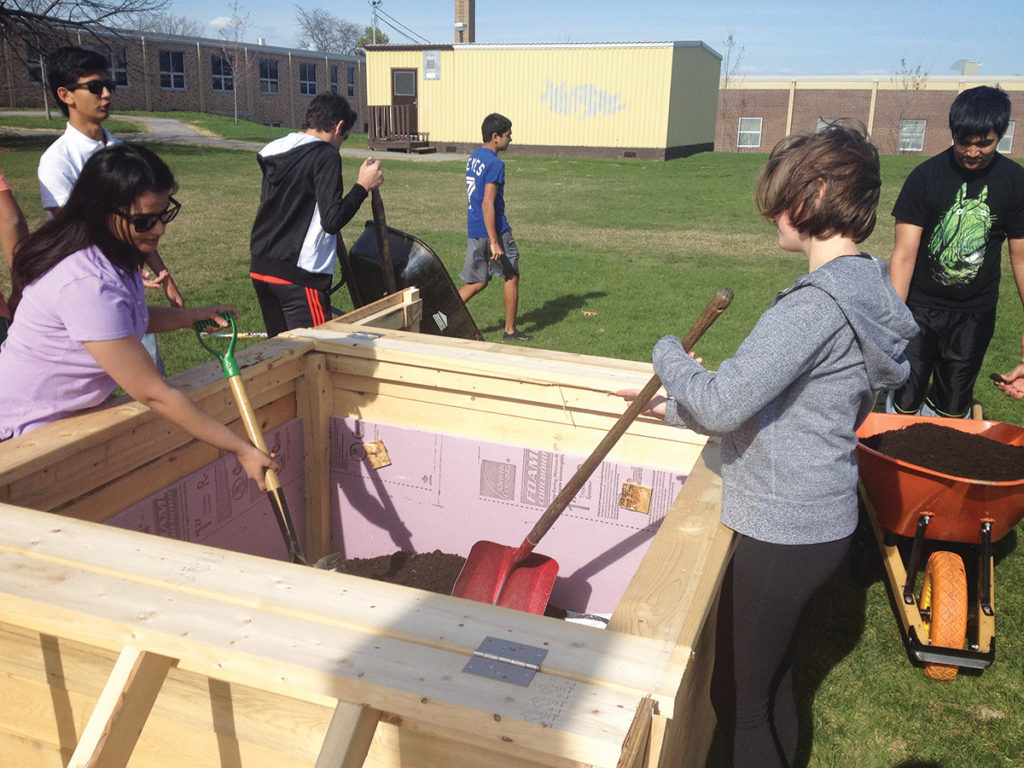On April 15, 2015, Dunbarton High School, located in Pickering, Ontario, received the “Greenest School On Earth” award from the Global Coalition for Green Schools, an initiative of the Center for Green Schools at the U.S. Green Building Council (USGBC). The school’s cutting-edge sustainability education program was chosen over forty applicant schools from around the world, mainly due to the level of involvement of both students and staff. The annual competition recognizes sustainability in building operations, educational curriculum and engaging commitment in daily activities. Rachel Gutter, director of the USGBC’s Center for Green Schools stated, “Dunbarton High School is an excellent example of a school that engages its students at every turn, placing them in the driver’s seat and empowering them to improve their environment, inside and out.”
 “The school was built at a time when no one cared about sustainability,” says Dunbarton’s David Gordon, teacher and advisor for the school’s Environment Council. “But we’ve found ways to make it green. We’ve shown that it is possible.”
“The school was built at a time when no one cared about sustainability,” says Dunbarton’s David Gordon, teacher and advisor for the school’s Environment Council. “But we’ve found ways to make it green. We’ve shown that it is possible.”
The Canada Green Building Council also named Dunbarton the Greenest School in Canada. As an inspiration, some of Dunbarton’s lengthy accomplishments are as follows:
- The school replaced its old windows with energy efficient ones and installed low-wattage fluorescent lighting and a rooftop solar hot water system.
- Two years ago, a 500-square metre pollinator garden was established beside Dunbarton’s 40-seat outdoor classroom. Many schools have nature gardens in which such flowers as hollyhocks and especially milkweed are grown for the survival of the Monarch butterfly.
- During the hot weather, the school has become cooler because 70 shade trees were planted by students who are also responsible to ensure they are watered during the summer months.
- As students enter grade 9, they are given a reusable water bottle.
- Students now place unwanted organics in neighbouring homes’ green bins that collect kitchen food scraps and yard trimmings for municipal composting.
- Students in the wood shop course built four garden boxes fitted with hinged plexiglass roofs. The boxes are filled with soil. Seeds are started at home before transplanting the seedlings into the boxes. When the plants are ready to harvest, the organic produce is donated to the community’s food bank.
- Bee condos have been built to help bees survive.
- Sustainability has been introduced into the school’s curriculum. Students can participate in the Atlantic Salmon Restoration Program and research their local Rouge National Urban Park. They monitor the school’s air quality and audit its electricity use.
- Dunbarton offers a Specialist High Skills Major in Environment and engages students through coursework and extracurricular activities related to the school’s natural surroundings. Students research the trees on campus and engage in climate change civic action projects.
“It is a great gift for us to be in this community and have the ability to provide students with so many fantastic opportunities related to sustainability,” added Gordon. “In Pickering we receive nothing but support for our sustainability initiatives from the board, Pickering City, local businesses, parents, universities and NGOs. They all provide our students with opportunities to deepen their understanding of sustainable practices, and with the chance to take action to make Pickering and Dunbarton High School demonstrably more sustainable. This is what the world needs to adapt to a changing future—young people prepared to take action in a supportive community.”
The Greenest School on Earth award recognizes a K – 12 school that exemplifies how sustainability can be woven into the infrastructure, culture and curriculum of a school. Dunbarton is the first school in North America to win this prestigious award. Along with the 2015 title, Dunbarton received a $1,000 prize that will be put toward the construction of ten new bee condominiums for its garden.
Honourable mention went to Vele Secondary School in Limpopo, South Africa. Past winners have included schools in Hong Kong, Kenya and Bali. “It’s really about helping our future,” said grade 11 student Sanwai Gilani, member of the school’s Environment Council.
“I’m interested in the environment and once I joined the club I started to learn so much about what we can do to help.” This speaks for the spirit of Dunbarton’s youth and indeed spreads encouragement and a challenge for all our educators and their students.
Congratulations to Environmental staff leaders, David Gordon and Karen Larter and to all the amazing students at Dunbarton High School.
For more information and submission requirements, visit: www.cagbc.org/greenestschool.
To learn more about the Greenest School on Earth and the center’s international efforts, visit: centerforgreenschools.org/greenestschool.
The Greenest School on Earth website states: “Recognition is an annual announcement made by the Center for Green Schools, highlighting a K – 12 school that exemplifies how sustainability can be integrally woven into the infrastructure, culture and curriculum of a school. The Center for Green Schools defines a green school as one that achieves zero environmental impact (including energy, water, waste and carbon), a positive impact on occupant health and performance, and 100% environmentally literate graduates. These are encompassed in three pillars—environmental impact, human health and eco-literacy.” Recipients will receive a $1000 grant to initiate or enhance a school sustainability program.
In Canada, schools that offer any grade from K – 12 are eligible to participate in the Greenest School in Canada competition, and will be judged on the following criteria:
- Efficient use of resources and reduced environmental impact.
- Enhanced health and learning among students, teachers and staff.
- Emphasis on sustainability and resource-conservation education.
U.S. Green Building Council – usgbc.org
Canada Green Building Council – cagbc.org
Center for Green Schools – centerforgreenschools.org
ABOUT THE AUTHOR
Larraine Roulston
Larraine authors illustrated books with resources that help teachers discuss benefits of composting. Visit: castlecompost.com.
This article is from Canadian Teacher Magazine’s Sept/Oct 2016 issue.












